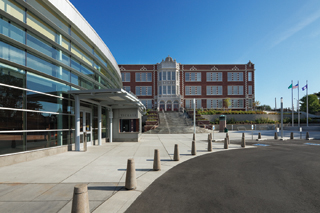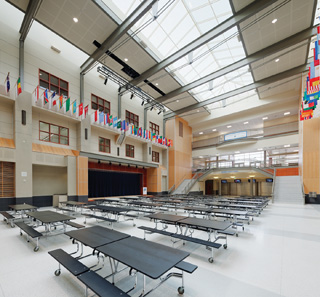|
Subscribe / Renew |
|
|
Contact Us |
|
| ► Subscribe to our Free Weekly Newsletter | |
| home | Welcome, sign in or click here to subscribe. | login |
Construction
| |
 |
August 25, 2011
Historic schools: Restore or replace?
BLRB Architects

Grulich
|
Listen to anyone who’s been around awhile and at some point you’ll probably hear that “they don’t make ’em like they used to.”
Nowhere perhaps, is this timeworn adage more appropriate than on the subject of historic schools. From their high ceilings, expansive windows, inspiring architectural details and the way they command their sites, historic schools have a rich patina and embodied energy that simply cannot be replicated in new construction.
As school districts examine options in today’s economic environment for maximizing student capacity, reducing operating costs and accommodating ever-changing educational programming, the question of whether to replace or restore historic schools looms large. Operational costs, programmatic adequacy, repair and modernization costs and more all require consideration in order to chart the most appropriate course.
Historic or old?
Since the term “historic school” is used broadly, the first point in the process may be an agreement about what differentiates a historic school from one that is merely old. Legally, historic schools are designated by a federal, state or municipal agency as such, and are formally recognized for their architectural and/or cultural significance. Even when not formally landmarked, a school can also be considered historic based on its contribution to the collective history of its community as well as its architecture.
The potential for rehabilitation of these schools is sometimes dismissed out of hand without a full — and informed — consideration of the facts and long-term implications of demolition or replacement. When considering the disposition of a historic school, there is more to consider than the financial implications of renovation or replacement, including the need for additional space, site benefits and constraints and, importantly, the capacity of the facility to support contemporary educational programs and technology.
Seek the facts
Misperceptions, assumptions and incorrect information regarding rehabilitation costs, programmatic sufficiency and the benefits of new construction on alternate sites can sink a restoration effort before it even starts.
Weighing the pros and cons of the full range of options takes preservation know-how, experience and creativity, and it’s important to engage an architect and consultant team with expertise in historic rehabilitation. Once an unbiased team with expertise in historic property assessment has been engaged, the next step is to conduct a feasibility study.
More than just a cost-benefit analysis, a feasibility study will examine bricks-and-mortar issues as well as technology needs and barriers, programmatic sufficiency, historic significance, and the potential implications of decisions for the surrounding neighborhood and community. A study conducted behind closed doors doesn’t tell the whole story: Community outreach and participation is key to the rehabilitation vs. replacement question.
Public voices
Too often, citizens are excluded from the feasibility study process. Formation of a citizens’ advisory committee is a foundational element for a well-rounded and accurate investigation. Broad issues of student benefit, school transportation efficiency and community vitality, as well as community-use potential, culture and character can best be determined in concert with school neighbors, community residents and municipal leaders.
The potential effects on the surrounding neighborhood of demolition, abandonment or new construction are important considerations in the quest to determine the feasibility of rehabilitation or replacement.
BLRB Architects, for example, worked with community-based planning committees of up to 40 representatives for rehabilitations of Hamilton International Middle School (2010) and Garfield High School (2008) in Seattle. The breadth of interests and points of view represented were invaluable in developing effective design solutions that satisfy contemporary educational needs and have broad community support.
Get creative
The abandonment of historic schools, especially in urban neighborhoods, is often seen as justified in terms of their incompatibility with contemporary educational specifications regarding minimum site acreage and classroom size standards. Usually, these specifications are more guideline than rule and can be overcome through creative design solutions to rehabilitation challenges.
As might be expected, BLRB faced significant site challenges on the rehabilitation of both Garfield and Hamilton, originally built in 1923 and 1927, respectively. At just 8.9 acres, Garfield’s site was required to house not only the original 170,000-square-foot, three-story building and an 83,700-square-foot addition, but also a full-size football/soccer field, 400-meter track and space for field events.
Additionally, Seattle Public Schools wished to incorporate parking and bus loading/unloading lanes on site to address the concerns of the school’s residential neighbors who experienced driveway blockage and side street congestion during loading and unloading periods. Another design directive from the planning committee was to develop a site plan that attracted students and their activities to the interior of the campus, rather than on the periphery near residential neighborhoods.
Collaborative planning, community inclusion and thoughtful consideration led to design solutions for each of these challenges that yielded a modernized school that meets contemporary educational needs yet maintains Garfield’s historic character, architectural significance and place within its community.
Contemporary needs
First and foremost in the rehabilitation vs. replacement debate is the question of whether or not the historic building can support today’s educational programming. Classroom size, spatial relationships, instructional and infrastructure technology — all of these and dozens of other issues are at the forefront of consideration.
Built in 1927 and known for academic rigor, Hamilton International Middle School infuses a global perspective into its daily curriculum. A primary design goal was to develop an environment that would support and enhance student success. The program at the nearly 900-student school is established around a small learning community model that was not adequately supported by the school’s original floor plan.
Hamilton’s rehabilitation included a complete reorganization of the interior space and the implementation of a design that features six independent small learning communities, each clustered around a shared flexible learning space.
Foreign language classrooms, applied technology labs and music program space support all of the learning communities, and a central daylit commons serves as the social heart of the school, supporting in-school meals, gatherings and performances.
Though 85 years old, Hamilton now is as contemporary in its interior design and programmatic efficiency as most new schools, and it has the added benefit of a preserved architectural character and community heritage that would not have been possible to achieve with new construction.
Though the rehabilitation of a historic school is not always a workable option, the viability of restoration deserves to be considered on an equal playing field with replacement. Project costs and educational adequacy are legitimate primary concerns, but they should share the stage with intangible costs and benefits, including neighborhood character and vitality, preserving our history, and shaping the future of our collective stories.
Gene Grulich leads BLRB Architects’ Historic Preservation Studio, which has managed more than a dozen historic school rehabilitation projects over the last 20 years in Washington and Oregon.
Other Stories:
- It’s time for Americans to rethink the classroom
- Designing schools for tomorrow’s scientists and engineers
- New schools are shelving the old library
- Boom times at Boise State
- Induction systems can cut school HVAC costs
- How technology is reshaping the way students learn
- What I’ve learned after 15 years of designing schools
- Tacoma elementary turns to Montessori to attract students




